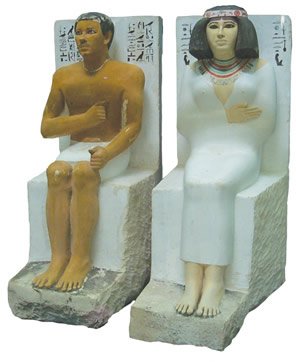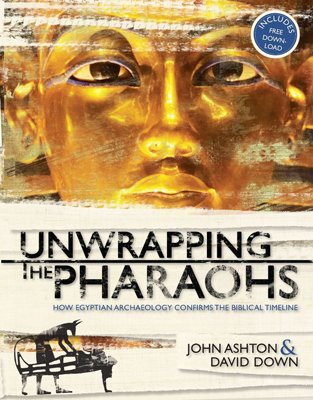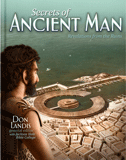
Chapter 4
Seneferu, the World’s Greatest Pyramid Builder
After completing one pyramid he kept on building until he got the perfect pyramid.
From Saqqara, the visitor can look south and see three pyramids, and they were all erected for one king, Seneferu, the first king of the 4th Dynasty. Now, no king can occupy three burial places at one time, so there has been much speculation as to the reason behind this. Some have suggested that he was just a compulsive builder and that having finished one pyramid he could not resist the urge to build another. Others suggest that he was a perfectionist. After completing one pyramid, he kept on building until he got the perfect pyramid.
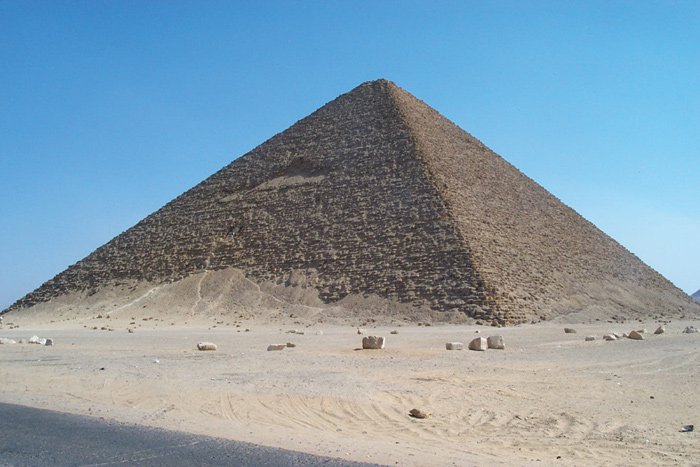
The Red Pyramid of Dahshur is probably the last pyramid Seneferu built. At its base it is 620 x 620 feet and 336 feet high (188 x 188 x 102 m) at the low angle of 43 degrees.
Others have speculated that he was a good politician adopting the principle, “Keep the peasants occupied. If they are building pyramids, they will not have spare time to sit around in coffee shops criticizing the government.” Whatever the reason, it has to be recognized that Seneferu was the greatest pyramid builder of all time. He must have used some nine million tons of stone to complete his monuments.
These were the first pyramids to assume the true pyramid form. Just why this form was developed is not clear. Some maintain that the sun’s rays penetrating a cloud and forming a prism gave birth to the idea of the pyramidal shape. Others see in the pyramid shape a pathway up to heaven. It may just be that the Egyptians thought of it as a neater way of building a pyramid than the Step Pyramid of Saqqara.
The Meidum Pyramid
At Meidum, the first of these three pyramids started out as a sort of step pyramid. It had a core of stone that rose in three tiers, and then the true pyramid form was built around this core. Whether this final form was planned from the beginning or came as an afterthought is open to debate, but whichever was the case, the true pyramid form arrived.
In its completed form, this pyramid measured 482 feet (147 m) from corner to corner and was 302 feet (92 m) in height, rising at an angle of 51.5 degrees, but when it was first observed by archaeologists, much of the outer casing lay in a heap at the foot of the pyramid. There are three theories to explain this. Some think that local builders removed stones for buildings in the nearest city, Meidum, and chiseled them to their desired shape at the site, leaving the chips in a heap beside the pyramid. Others claim that the outer stones were of inferior quality and gradually crumbled over the thousands of intervening years.
In 1974, Kurt Mendelssohn wrote a book called The Riddle of the Pyramids,1 in which he claimed that these outer stones had suddenly collapsed with a thunderous roar before the pyramid was completely built. As evidence, he noted that the burial chamber had never been finished, and after all, that was what a pyramid was all about. He also pointed out that there were two stelae (slabs of stone) on the roof of the shrine at the east side of the pyramid, and these stelae had never been written on.
Mendelssohn was a physicist, not an archaeologist, but he had put a lot of research into the building of the pyramids, and he claimed that as a physicist he knew more about building construction than archaeologists do. In his opinion, the collapsed rubble was a “plastic flow,” which would have come about from a sudden collapse rather than from slow disintegration. Mendelssohn’s theory received general acceptance from most archaeologists at the time, but more recently his theory has been challenged.
In 1984, Egyptian archaeologists started removing the chips with front-end loaders and dump trucks to expose the remaining stones in the core. This was rather drastic treatment and was fortunately later replaced with manual labor. After all, if there were any clues in the rubble as to how the collapse occurred, they would not be found by front-end loaders.
More recently, George Johnson investigated this pyramid and reported his findings in KMT, A Modern Journal of Ancient Egypt.2 He says that he went to Meidum to find support for Mendelssohn’s theory but was disappointed to find that this view was untenable. He agreed that the evidence showed that the pyramid was never completed, but the failure to complete it was not due to a collapse.
Some graffiti in the funeral chapel on the east side of the pyramid had been left there by pilgrims who came there during the 18th Dynasty. One stated, “On the twelfth day of the fourth month of summer in the forty-first year of the reign of Thutmosis III the scribe AA-Kheper-Re-Senb, son of Amenmesu . . . came to see the beautiful temple of King Seneferu. He found it as though heaven were within it and the rising sun in it. Then he said, ‘May heaven rain with fresh myrrh, may it drip with incense upon the roof of the temple of King Seneferu.’ ”
This inscription reveals that at least at that time this pyramid was regarded as belonging to Seneferu, and it proves that the rubble could not have covered the chapel at that time. Sir Flinders Petrie claims that he found some burials from the 22nd Dynasty in the rubble 33 feet (10 m) above the funerary temple, so the rubble must have been there then. The debate continues, leaving us with more questions than answers.
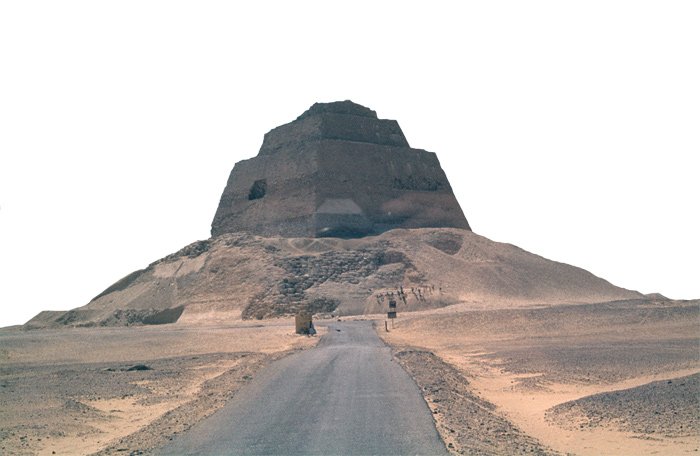
The pyramid of Meidum was probably the first true pyramid ever built. The outer stones have disintegrated leaving the square core around which the true pyramid form was built.
In recent years, Meidum has been developed as a tourist site. A paved road leads to the pyramid and street lighting has been installed. Visitors can climb the mound of rubble to the entrance to the pyramid and explore its interior. A passage slopes downward into bedrock, meeting a horizontal passage which terminates in a vertical shaft ascending to the burial chamber. At the foot of this shaft are some hefty cedar logs spanning the width of the passage. Some claim that they may have been used to hoist the sarcophagus up to the burial chamber. There are some other logs in the burial chamber itself. Other scholars claim that it is more likely that the logs were supplied by tomb robbers who were getting the sarcophagus out of the pyramid—more unanswered questions.
Actually, not all archaeologists are convinced that this pyramid was built by Seneferu. No pyramid for his predecessor Huni, the last king of the 3rd Dynasty, has ever been found, so they suspect that this may have been built by Huni, or at least started by him, but there is more than one inscription at the pyramid which includes the name of Seneferu, so he seems to have been the builder.
Just to the northeast of the pyramid there is a mastaba belonging to one of the royal princes, Nefermaat and his wife, Itet. The entrance to this mastaba is on the east side, but this entrance was plugged with huge blocks of stone after the burial. Not to be outdone, tomb robbers burrowed into the south side and penetrated to the burial chamber.
These robbers did not waste time on making their entrance passage any bigger than they needed it to be, so visitors today do not find it easy to squirm along the passage to the burial place, but it is a worthwhile exercise. The sarcophagus is still there and the lid is still on top at a rakish angle. When the robbers pried the lid apart to get their hands on the valuables, they propped it up with a wooden mallet they had used to chisel their way through the stone casing of the tomb chamber. That mallet is still there, propping up the lid.
There are several mastabas attached to the Meidum pyramid. One of them belonged to the king’s son Rahotep, who was also a high priest in the realm. The statue of him and his wife, Nofret, is one of the outstanding exhibits in the Cairo Museum today. Nofret’s skeleton was still in the tomb with each bone wrapped separately, and Petrie sent them to England, but they have since been lost. As Petrie once remarked, “A museum is a dangerous place.”
The Bent Pyramid
Seneferu’s next great building project was the Bent Pyramid of Dahshur. It is the best preserved of all the pyramids of Egypt, most of its facing stones being still in position. For many years this pyramid was off-limits to tourists because of a military camp at its base, but thanks to more peaceful relations between Israel and Egypt, the camp was removed, and in 1997 this and the nearby Red Pyramid were thrown open to visitors.
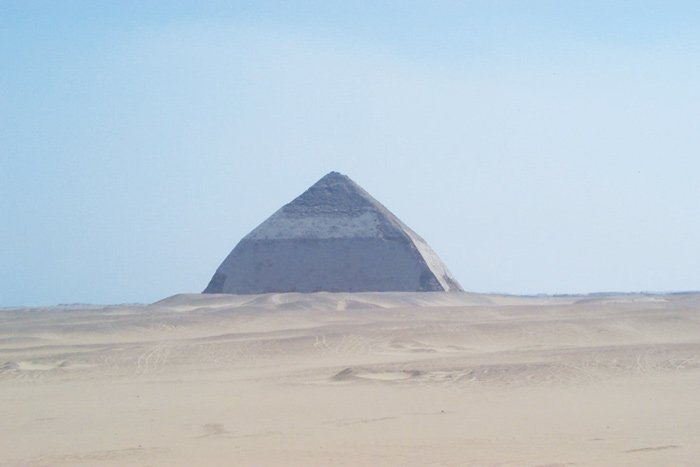
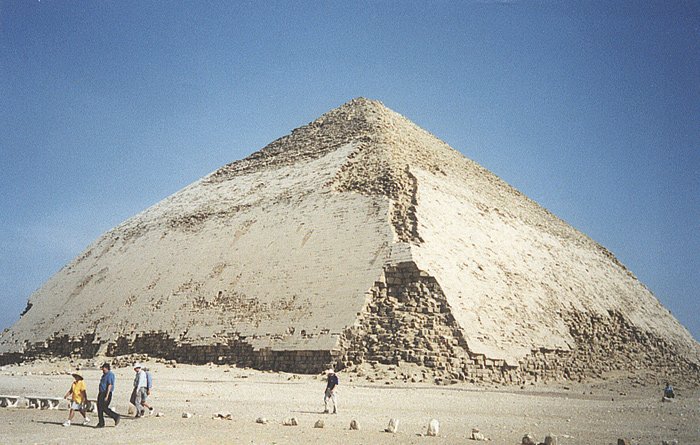
The Bent Pyramid, pictured here from different sides, is so named because of the difference in angle of the top half to the lower half. The outside facing stones are better preserved on this pyramid than any other pyramid in Egypt.
At its base, the Bent Pyramid is 617 feet (188 m) square, and its angle of elevation is 52 degrees. Had this angle been maintained, its height would have been 335 feet (102 m). For some unexplained reason, halfway up the angle was changed to 43 degrees, giving rise to its name “the Bent Pyramid.”
A multitude of explanations have since been invented for this odd change. “The king ran out of money and finished it off more economically; the king died and his successor finished it off on the cheap; the two halves represent Upper and Lower Egypt.” None of these arguments are very convincing. Perhaps the most plausible explanation is constructional problems. Cracks caused by the enormous pressure of weight have been observed in some of the lower stones. Maybe the builders advised it be finished at a lower angle to reduce the risk of collapse.
The internal design is unique among pyramids. It has two entrances, one in the north face and the other in the west, and two separate tomb chambers, although at some time they were connected with a passage. There was not even a sarcophagus in either of these two chambers, far less a body.
A vital clue to the length of time taken to build a pyramid was provided by a workman’s writing in red ochre on the outside of the pyramid. On a casing block at the base on the northeast corner of the pyramid is a reference to the 21st year of Seneferu, and halfway up is a reference to the 22nd year of the same king. This would suggest that building the lower half of the pyramid only took about two years. This seems to have been an impossibility, for it would require the builders to work 12 hours a day placing one of the building blocks (which average around 2.5 tons) precisely in place every 20 seconds or so.
The Red Pyramid
The last of the three pyramids built by Seneferu is the so-called Red Pyramid, not far north of the Bent Pyramid. This structure has a base length of 722 feet (220 m) and is at a much lower angle than any other, a mere 43 degrees, significantly the same angle as the top half of the Bent Pyramid. Its height is 344 feet (105 m). If, as seems likely, Seneferu’s engineers had construction problems with the first two, the king may have reasoned that this one, at least, would not fall down on him after he was buried.

Inside the Red Pyramid a passage leads to a large room with corbeled walls, designed to deflect the enormous weight of the upper stones on the ceiling.
Much of the outside facing stone has been stolen, so it is only the reddish construction stone which can be seen, although the pyramid’s capstone is still there. The construction stone glows in the setting sun, and this has given it the name of the Red Pyramid. On this pyramid also is some writing mentioning the 21st and 23rd years of an unnamed king. If this was Seneferu, it is staggering to think that he was building two huge pyramids at the same time.
From the entrance to the pyramid, a passage slopes down to ground level where there are two spacious antechambers. From the second of these, a horizontal passage ascends to a lofty tomb chamber. Some human remains were found there, but whether they belonged to the king or not cannot be determined.
Unwrapping the Pharaohs
Adults and children alike are fascinated by Egyptian civilization. But most modern archaeologists have lately tried to use Egyptian chronology to dispute the biblical record. Secular textbooks and videos challenge the faith of students and discredit the biblical account of Exodus. Those who wish to defend the accuracy of the Bible now have an incredible tool in this exciting book that provides compelling confirmation of the biblical account.
Read Online Buy BookFootnotes
- Kurt Mendelssohn, The Riddle of the Pyramids (London: Cardinal, 1976).
- George B. Johnson, “The Pyramid of Meidum: The Victim of Collapse?” KMT (A Modern Journal of Ancient Egypt), vol. 4, no. 2 (1993): p. 64–71.
Recommended Resources

Answers in Genesis is an apologetics ministry, dedicated to helping Christians defend their faith and proclaim the good news of Jesus Christ.
- Customer Service 800.778.3390
- © 2024 Answers in Genesis

